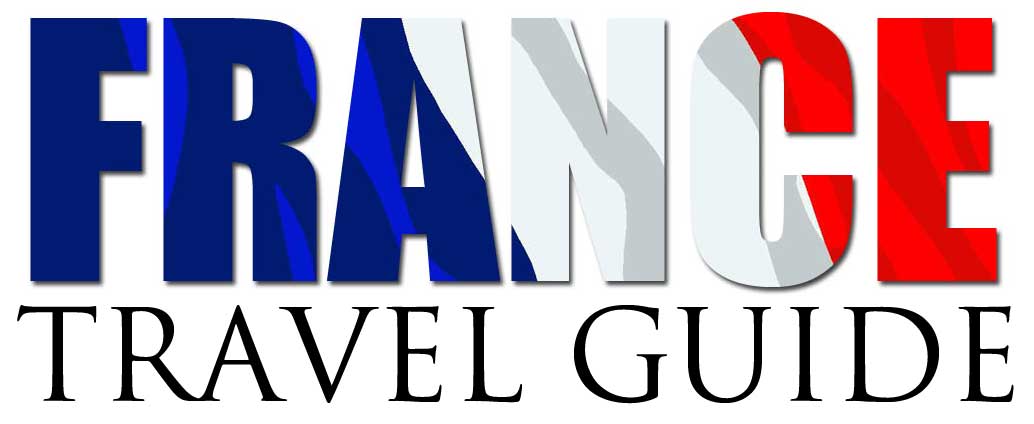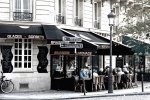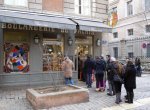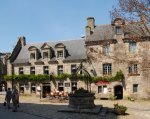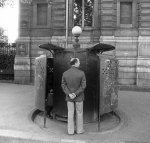vaucluse (84)
region: Provence-Alpes-Côte d’Azur
The Provence that so enthralled author Peter Mayle, and which encouraged him to put his love of the region into print, is alive and well, and every bit as stunning as ever it was.
Within this adorable region, the landscapes of the Vaucluse are as
beautiful and beguiling as elsewhere. But what most takes first-time visitors
by surprise, perhaps more so than anything else, is the mesmerising luminosity
of the light; small wonder that so many artists found it appealing. You have
only to sit peaceably on some bar terrace in one of the mountain villages,
perhaps savouring an inexpensive Cotes de Ventoux, and take in the light,
especially as the sun goes down, and you will understand; it is not something
you can imagine.
And with the light come the palpable aromas of Provence, heady scented, wafting on a breeze, the perfumes of lavender and the herby tang of the garrigue; there’s fruit there, too, the smell of olives and the vine for which the region is renowned. To make matters even more irresistible, there is the landscape itself, a most exquisite canvas of green oak woodland and glaring limestone rising steadily to and dominated by the breezy heights of Mont Ventoux (a UNESCO Biosphere Reserve), and dotted with innumerable villages of simple design and rustic fascination. What makes this region such an attraction is that there is so little with which to find fault, and probably less than that. Of course, that is a rose-coloured spectacle view; winters here can be ferociously cold and draughty, whenever the Mistral decides to put on a show, while fighting ‘Madame’ for the last baguette at the boulangerie could be one hazard too far.
Defining the Vaucluse, geographically at least, defeats many people, French included. It is roughly synonymous with Provence, but not entirely so. Nor is the situation helped by the fact that from the limestone summit of Mont Ventoux you gaze across a complicated spread of sub-regions: westwards across the crinkly Dentelles de Montmirail into Haut Vaucluse, south to the Vaucluse plateau and over the Monts de Vaucluse to the Lubéron. While the agreeable villages of Fontaine-de-Vaucluse and Saumane-de-Vaucluse lie within the Pays des Sorgues. If the region has to have a boundary, then on the east and south it is the Durance river and on the west, the Rhône. Within this framework lie no fewer than 151 towns and villages, the largest of which are Avignon and Carpentras (don’t pronounce the ‘s’, unless it’s on Gigondas).
HIGHLIGHTS
Avignon, with a population in excess of 180,000, has all the major commerce, its own airport, TGV links, and sits (almost) on the motorway network. Its renown is largely based on the fact that during the 14th century the Papacy was domiciled here. The Palais des Papes to this day remains a magnificent building adjoined by other equally stunning architectural monuments and gardens, and few could deny that Avignon is a magnificent, thriving and popular city, and worthy of its status as a World Heritage Site.
But it is Carpentras and the surrounding countryside of the Vaucluse that holds especial appeal, and is promoted as the ‘Porte de Ventoux’. This is the land of lavender, wine and gourmandise, with weekly markets somewhere on every day of the week selling fruits, vegetables, herbs, spices, olive oil, honey, clothes and fabrics, the largest, arguably in Vaison-la-Romaine. Few of the towns and villages don’t have a market at all, that at Sault boasts a market dating from 1515, and the whole mildly chaotic caravan of consumables is supported by town-edge supermarkets.
A predominance of upland and mountains, steep sided and cloaked in trees, means that most settlements are shoe-horned into river valleys, although a few villages perchés do occupy isolated hill tops, notably Venasques and Gordes, and less well known along the Toulourenc valley on the north-eastern side of Mont Ventoux.
At the northern edge of the Vaucluse, Vaison-la-Romaine, built along the Ouvèze river, is an superb small town, a place of considerable antiquity, being more than 2,000 years old. Its assembly of historical ruins, important Romanesque architecture and strategic position combine to make this an important and most satisfying place. The modern town is built on top of parts of the oldest town, while, confusingly the Haute Ville across the river with its chateau and network of narrow cobbled streets, is often referred to as the Old Town. Come here on a Tuesday and your market day experience will be like no other. There is evident wealth about Vaison, based on a thriving wine production industry, along with fruit, honey, truffles and lavender.
South of Vaison you run down a delightful string of villages, each producing their own wines, and each with its own characteristics. Séguret is one of the most beautiful of all French villages and renowned for its very narrow streets and ancient lavoirs, as well as for the manufacture of brightly painted miniature dolls made in clay, known as santons, most of religious or pastoral significance. Continuing southwards you reach more small villages famed for their wine: Gigondas, Vacqueyras and Beaumes de Venise, the last producing a sweet wine from Muscat grapes.
The Monts de Vaucluse form a magnificent scrubby, woody, karstic barrier, a kind of massive sleeping policeman between the Gorges de la Nesque to the north and the Calavon to the south. The Nesque rises on the slopes of Mont Ventoux and on its way to meet the Sorgues near Pernes-les-Fontaines fashions a stunning gorge through the limestone rocks of the Vaucluse plateau. The scenery is splendid: a meandering river, scrubby garrigue, and oak forest above which rise the white limestone crests so typical of the area. But nothing quite prepares you for the gorges itself, a dramatic water-fashioned ravine of considerable depth across which an ingenious road traces a terraced route.
The village of Venasque must have seemed impregnable to any invading forces, perched as it is at the top of sheer cliffs, and today it is considered to be typical of the villages of Comtat Venaissin, to which it has given its name. The village, which has acquired a reputation for growing cherries, is listed in the Historical Register as vernacular in architectural style, which effectively means that any restoration must be carried out consistent with maintaining the original character.
Much the same might be said of Gordes, the buildings of which rise crazily, stacked like boxes, above the Imergue valley. The Romans found this site of strategic importance, too, and later the village developed during the 11th century. But for Gordes it was not all sweetness and light. The Middle Ages, the Renaissance and the Wars of Religion all impacted on this near citadel, but by the 18th and 19th centuries the village had recovered sufficiently to support a number of small cottage industries of cobblers, tanners, silk weavers and olive oil producers.
East of Gordes, another hill-top village, Roussillon, is renowned for the varied ochre colours of its rocks, which feature in many of its houses and other buildings. Ochre from the Vaucluse is of such a quality that it has made France one of the major producers of the pigment in the world. Roussillon is an agreeable place, its main street rising to a cluster of restaurants and bars, while artwork and the production of pottery, both of which have a vibrancy of colour that is even more intense than that normally associated with Provence, has a strong place here.
TOURIST INFORMATION
Vaucluse Départemental Tourism
Comité Départemental du Tourisme de Vaucluse, 12 rue Collège de la Croix, BP147, 84008 Avignon
Tel: 04 90 80 47 00
www.provenceguide.com
Provence-Alpes-Côtes d’Azur Regional Tourism
Comité Régional de tourisme Provence 61, la Canebière, 13231 Marseille
Tel: 04 91 56 47 00
www.tourismepaca.fr
getting there
The main town of Avignon lies 430 miles south of Paris. Carpentras is about 30 minutes’ drive, east of Avignon.
By car:
Two autoroutes enable you to reach the region from Paris: the A6/A7 via Lyon.
By rail:
Avignon is linked with Paris (3h30) by up to 15 services per day (www.voyages-sncf.com). Voyages-SNCF is the official distributor in the UK for the French railways (SNCF), and can also book tickets on Eurostar.
By air:
Air France fly daily from Paris (Orly) to Avignon; Flybe fly direct to Avignon during the main tourist season from London and some regional airports.
Recent Articles
-
French Food and Drink - No BS Guide for lovers of Food, Wine, Liqueurs
Aug 28, 19 03:18 AM
Our guide to French food and drink for those who love traditional French food along with our no BS guide to understanding French wine and liqueurs
-
Things To Do In Carcassonne The Ultimate Tourist Guide
Aug 24, 19 06:26 PM
The ultimate tourist guide to things to do in Carcassonne when you visit this wonderful town in Aude France. Discover the places to go and see in Carcassone.
-
Lyon Old Town Guide to Vieux Lyon
Aug 18, 19 07:48 AM
Your complete guide to Lyon old town otherwise known as the Vieux Lyon. Don't miss this amazing part of the city if you're visiting Lyon in France.
-
18 French Villages You Must Visit Most Beautiful Villages in France
Aug 17, 19 06:31 AM
Our guide to the 18 most beautiful French villages you simply must visit. Loads of info, photos and facts in our ultimate villages in France tourist guide
-
What a Pissoir - The True Story of France's Unique Urinals
Aug 13, 19 03:47 PM
Is there anything more French than a pissoir? Sadly on the decline nevertheless the pissor is an endring image of the country. This is their story
